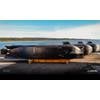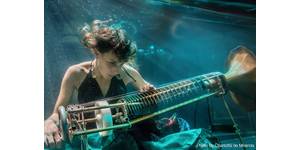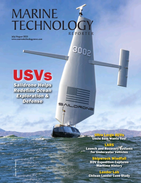CMRE Leads Large Glider Experiment

A glider is launched as part of an initiative lead by CMRE to enhance environmental knowledge (Photo courtesy of CMRE)
CMRE leads large glider experiment in the Sardinian Sea to enhance Environmental Knowledge and Operational Effectiveness (EKOE) capabilities. The REP14-MED sea trial includes 21 partners from six Nations. From June 6-26, 2014, onboard NRV Alliance and German research vessel Planet, and at research centers ashore, experts from those institutions will be working on the future of ocean monitoring and seabed characterization.
From June 6-26, 2014 the Sardinian Sea will be the site of the REP14-MED experiment, lead by the NATO Center for Maritime Research and Experimentation (CMRE), part of the NATO Science and Technology Organization. Onboard the NATO Research Vessel Alliance, operated by CMRE, and onboard Research Vessel Planet, operated by the German Research Center WTD71, as well as remotely at research centers ashore, scientists and engineers from 21 partners and six Nations, will test and develop new systems, technologies and solutions for ocean monitoring and seabed characterization, in order to enhance current Environmental Knowledge and Operational Effectiveness (EKOE) capabilities.
The main pillar of the experimentation is the use of underwater gliders from four Nations (U.K., Germany, France and U.S.A.) and from NATO CMRE. Gliders are Autonomous Underwater Vehicles (AUVs) that use changes in buoyancy to dive and surface, and have wings to generate horizontal motion as part of this process. This unconventional method of propulsion (without the use of a propeller) is very energy-efficient and provides gliders with a long endurance that is well suited to monitoring the ocean.
In REP14-MED, a large number of gliders from different Institutions and manufacturers are simultaneously at sea to collect ocean physical data to improve the performance of ocean forecast models; diagnose and predict physical properties of the waters west of Sardinia; develop and test efficient sampling strategies; develop and test new methods to characterize the seabed; record underwater ambient noise; and test recent developments in underwater observation techniques. CMRE gliders will be operated from the CMRE Command and Control Room in La Spezia, including new hybrid gliders capable of being switched between the standard gliding mode of propulsion and a faster (but less energy-efficient) mode that uses a propeller.
The partners’ consortium also comprises, among others, the Area Marina Protetta Penisola del Sinis (AMP) and the Istituto per l’Ambiente Marino Costiero del CNR (IAMC-CNR), both active in the local area.
Through REP14-MED, NATO will enable collaborative research to increase automation and effectiveness of coordinated geographical, meteorological, and oceanographic support for NATO operations.
cmre.nato.int












 August 2025
August 2025



